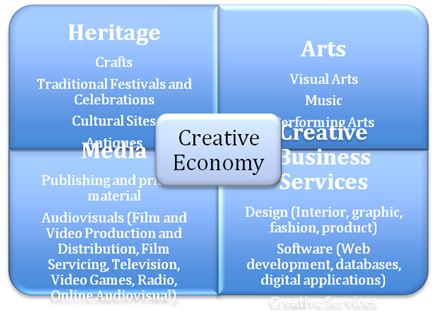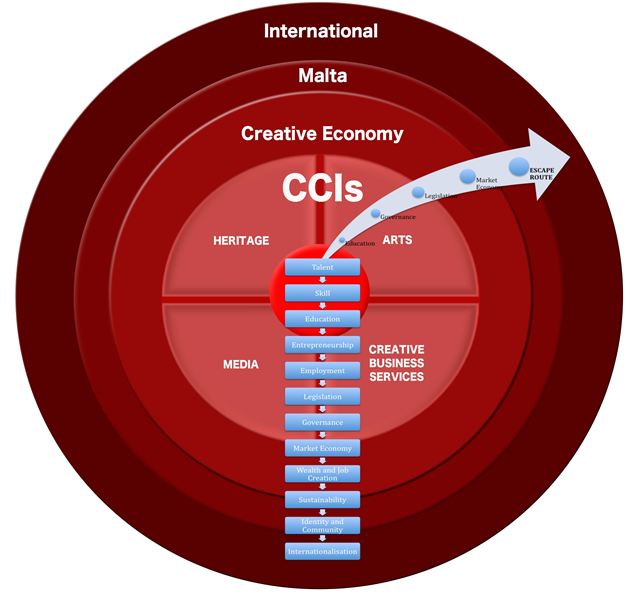The mandate to establish the Creative Economy Working Group was announced by the Minister of Finance, Economy and Investment in 2009 during the 2010 Budget Speech. The Creative Economy Strategy entitled Creativity Works is expected to be publicly available in 2012. The document defines the Creative Economy Project in the following terms:
“Creativity is the engine of the global economy. Those countries capable of developing and supporting an environment where the creative talent of the population is brought forth and prospers are the countries most capable to support their economic and social development. The creative areas of the economy, which include ICT, films, arts and design, as well as performing arts and others, create a lot of high value-added work, support other sectors within the economy, like tourism, manufacturing and other sectors, and at the same time create a vibrant and innovative environment in those contexts where these sectors develop. Thus, even the people’s quality of life improves. We will therefore continue to incentivise this sector consistently with the Vision 2015 to make our country a centre of excellence in various sectors, including that of creativity. In this context, […] we will create a working group to draft the regulatory and fiscal organisational framework for the promotion of the creative economy.”
The objectives of the working group were:
- to assess the potential of Malta’s CCIs by mapping, consulting and reviewing the sector;
- to address the professionalisation needs of the sectors within the creative economy;
- to develop a strategy that will generate income and create jobs in the creative economy;
- to internationalise Malta’s creative economy; and
- to maximise and synergise public and private resources for the creative economy through effective economic, legal and administrative processes.
In order to reach the identified objectives, the CEWG implemented the following tasks:
- enacted government’s decision to develop the cultural and creative industries as a pillar of Malta’s economy as part of Vision 2015;
- coordinated and implemented the Creative Economy Project as identified in Budget 2010;
- developed a cohesive national strategy for the cultural and the creative sector, based on the sector’s potential social and economic impacts and benefits;
- articulated and defined the governance and legal framework for the sector;
- reviewed the usage and effectiveness of current fiscal measures and other incentives with a view to the medium and long terms needs for the development of the sector;
- coordinated with key related national initiatives, namely the preparatory work for the European Capital of Culture and the implementation of the relevant national policies, especially the Malta Cultural Policy; and
- ensured that the strength of Malta’s cultural and creative sector reflects diversity of cultural expression, resulting in social cohesion and inclusion and a better quality of life for all.

Following the establishment of the Creative Economy Working Group, the Cultural and Creative Industries were identified as an economic pillar in government’s economic vision 2015 and beyond and enlisted as a commitment in the Euro Plus Pact.
The Creative Economy Working Group (2010) defines the Creative Economy as a set of knowledge based economic activities (creative and intellectual capital) encompassing the cycles of creation, production, and distribution of creative goods and services, that have the potential to generate economic growth, employment and development.
The pillars of the creative economy are the Cultural and Creative Industries: Heritage, Arts, Media and Creative Business Services. Creative Workers and Cultural Assets are at the heart of the CCIs. Through talent, skill, entrepreneurship and IPR, the creative worker can generate new jobs and companies, and help mature industries to re-tool for the future.
Key economic indicators:
|
CCIs accounted for 5% of GDP (2008-2010) 6.2% annualised average growth (2000-2007) | ||
|---|---|---|
|
Number of enterprises: 3 822 (2010) |
People employed: 14 500 |
Average wage : EUR 17 231 p.a. |
|
GVA: EUR 322 million (2010) |
GVA per employee: EUR 31 065 per person employed |
Average annual growth in GVA per employee: 7.8% (2008/10) |
| Public expenditure in culture and creativity: EUR 27 million (2013) | Gov.exp. per capita: EUR 62(2012) EUR 64 (2013) |
Gov. CCI exp. as a share of Total gov.expenditure: 0.9% (2012) |
| Tourist expenditure on the CCI sectors: EUR 77.2million (2012) 7.8% of total tourist expenditure | Exports of cultural and creative goods[1] : EUR 147 million (2012) Increased at an annual average rate of nearly 14% (2008-2012) | Exported cultural and creative services[2] rose at a considerable annual average growth rate of over 60% (2004-2008). Main sectors driving growth: audiovisual services, advertising, and architectural services. |
Identifying the key issues for the CCIs in Malta
and addressing these needs strategically.

Source: Creative Economy Working Group (2011).
The aim of the Creative Economy strategy is to identify the barriers that are currently hindering growth for cultural and creative practitioners in Malta. As the key stakeholders of this strategy that position themselves at the heart of the CCI model, 12 steps were identified as check points for growth within the sector. The narrative is not always linear; however it often takes a practitioner through a daunting journey that is highly dependent on the personal and external environment. At the core of the model one finds talent and skill without which no cultural and creative action can take place. (Issue 1. How do we identify and nurture this talent at an early age?)This often requires the necessary mentoring, coaching and training delivered by education institutions. (Issue 2. Are we delivering this professional training?) Following extensive vocational and academic training, cultural and creative professionals seek out employment or are more likely to create their own job (Issue 3. Is there a market and do they know how to find route to market to survive and grow). This often requires appropriate legislation and governance structures to champion the sector and legislate for its professional status (Issue 4. Do current governance structures respond to the needs of the industry?). Cultural and creative practitioners cluster in cities and countries with dynamic creative ecosystems. In return this provides wealth, creates jobs and drives forward innovation (Issue 5. How do we facilitate the interlinkages between various cultural and creative sectors?) The creative environment is rooted in the community and the identities of the country which through voluntary activity passionately celebrates its traditions. (Issue 6. How do we prioritise professionalisation and give value to community activity that often serves as an incubator for professional activity?)Cultural and creative practitioners need to feel culturally at home, creatively free and actively global. (Issue 7. How ambitious are we to reach international markets and how do we access them?)Ultimately, a creative ecology can only be sustainable and rich if it hosts diverse people, sectors and thrives through exchange. (Issue 8. How can Malta become more attractive to international entrepreneurs investing in the creative industries?)
“Brain drain” featured as the most visible threat to the future of cultural and creative industries in Malta. When excellent talent and strong skills are lost due to lack of specialised training or if Malta is perceived as a nation of limited creative opportunities, internalisation does not become a stepping stone but an escape route to pursue one’s potential. The strategy champions the belief that this creative potential can be nurtured into a booming creative economy.
The Strategy addresses:
Governance: It analyses current governance scenarios, establishes needs and direction, investigates and compares potential scenarios and defines the way forward. Ministries, departments and public agencies that are directly involved in policies and strategies for any area of the creative economy should be assessed, consolidated and re-enforced into an effective and efficient model. This will mitigate a fragmented governance structures and maximise the effective use of government resources in CCIs.
Shaping talent into professions – The human capital is central to the creation process, and the strategy seeks, together with education institutions, to ensure the nurturing of a creative workforce in response to the needs of the sector and the growing demand in CCIs.
Routing Creative Ideas to Market – The strategy prioritises the development of creative clusters and the mechanisms for access to finance in order to address barriers hindering creative businesses in finding route to market.
Malta: A hub of creative exchange –
Support is proposed for investments in Valletta as a cultural city and
its potential as a European Capital of Culture in 2018, international
co-productions, marketing and promotion in international fairs and
festival circuits. International relations, enterprise incentives, and
cultural diplomacy are streamlined through the appropriate structures in
order to maximise existing networks, and boost exposure and exports of
CCIs. Awareness and use of IPRs is improved and promoted as a central
tool for the industries to make a profit via licensing, transfers,
assignments and other commercialisation ventures.
[1] Which includes Crafts (carpets, celebrations, other paper, wicker ware and yarn), Audiovisual (film), Design, (architecture, fashion, interior and jewellery), New Media, and Music, Publishing and Visual Arts (antiques, paintings, photography and sculpture)
[2] Excluding recreational services exported which include mainly remote gaming services

Comments are closed.